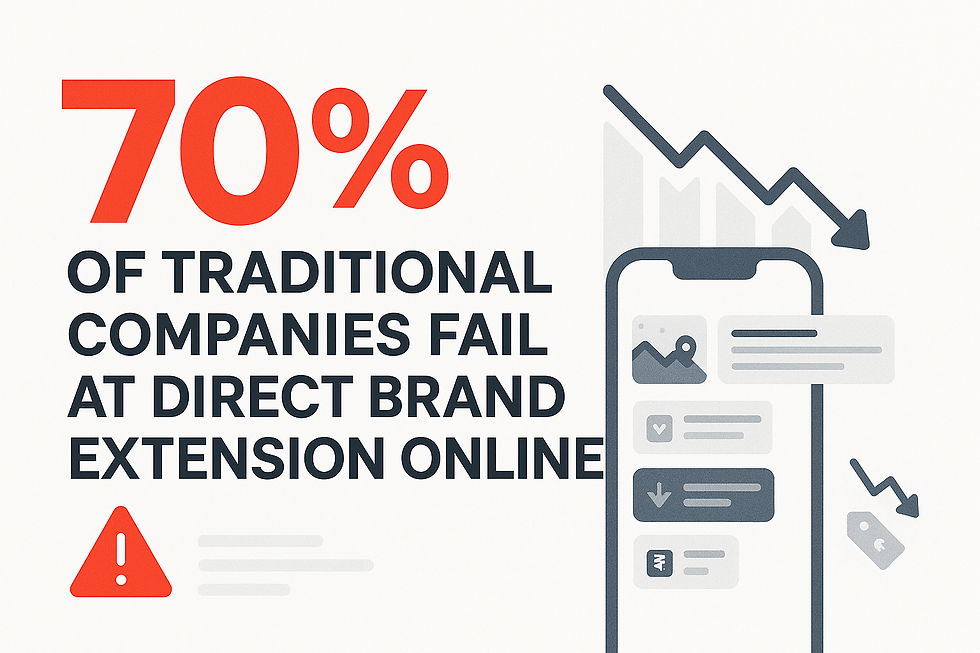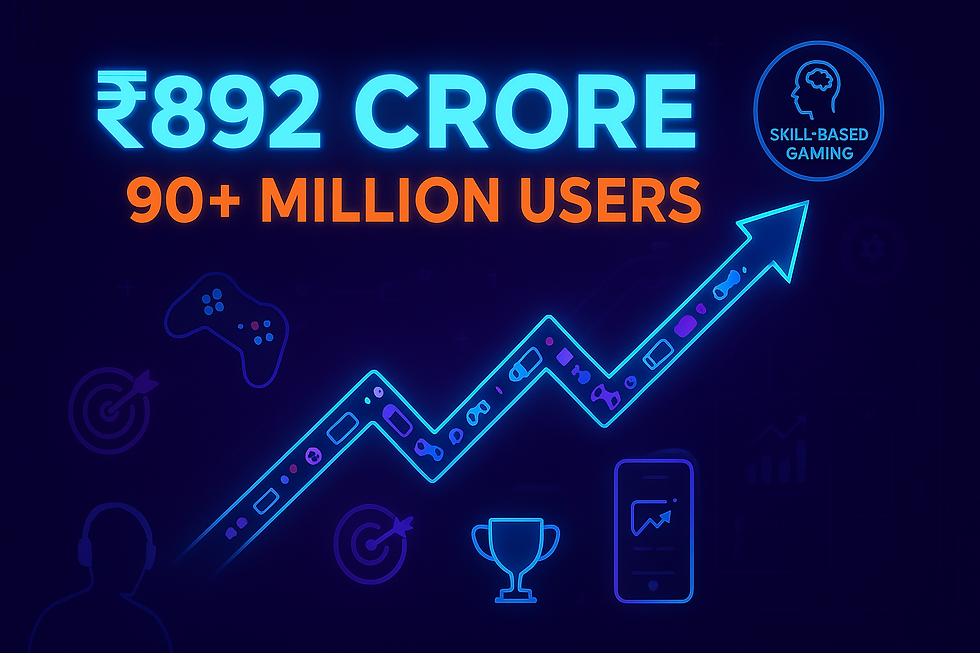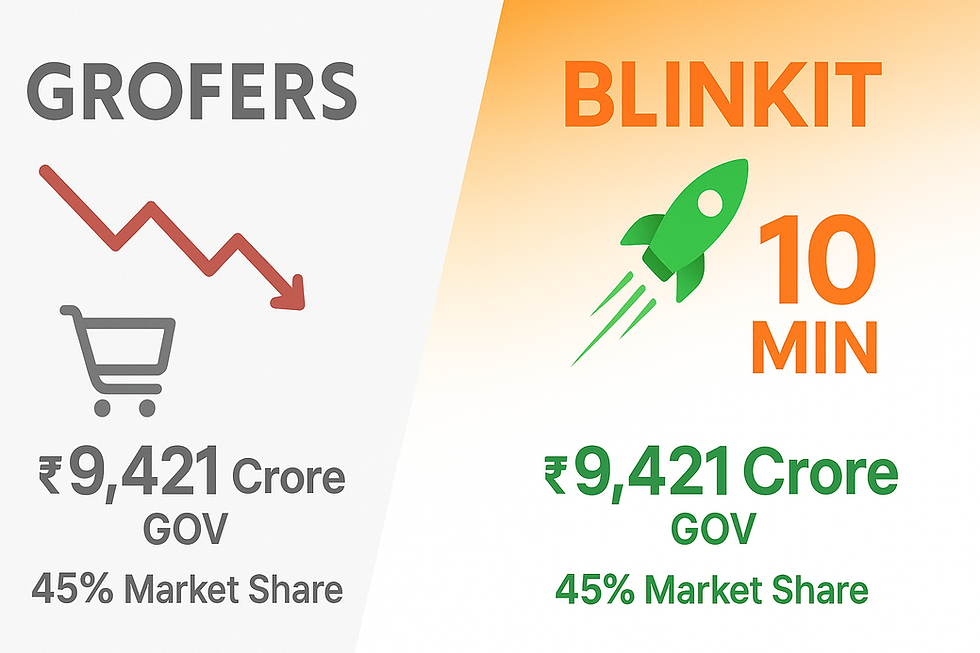Tata Digital's Super App Strategy: How Traditional Giants Fight Tech Startups
- Nayan Tomar
- Jun 27
- 4 min read
₹15,000 crore investment, 100-year brand legacy, yet struggling against 10-year-old startups—Tata's digital transformation reveals why 70% of traditional companies fail at direct brand extension online.

Reading Time: 5 minutes
The Paradox of Legacy Strength Becoming Digital Weakness
When Tata Digital launched Tata Neu in April 2022 with massive IPL fanfare and over ₹11,872 crore in funding, it seemed like the perfect storm for super app success. A 155-year-old conglomerate with unmatched brand trust, 20+ consumer brands, and 120 million existing customers should have easily competed against digital startups. Instead, Tata Digital reported combined losses of ₹4,700 crores in FY23, forcing the group to halt fresh investments for the first time in eight years. This dramatic contrast illustrates what marketing strategists call "legacy brand digital paradox"—where traditional strengths become competitive disadvantages in digital-first markets.

The challenge wasn't funding or brand recognition, but fundamental differences in digital marketing DNA. While native digital players like Amazon and Flipkart built customer acquisition systems around data-driven personalization and agile user experience optimization, Tata Digital attempted to replicate offline success through brand equity leveraging strategies that don't translate to digital behavior. Users complained that Tata Neu's search engine was significantly slower than competitors, the app was buggy during launch, and the integrated experience felt forced rather than seamless.

This reveals a crucial insight: legacy brands need separate digital identities rather than direct brand extensions to succeed online.

The Marketing Strategy Mismatch: Trust vs. Convenience
Integrated Marketing Across Multiple Brands vs. Focused Value Propositions
Tata Digital's strategy centered on ecosystem cross-promotion, assuming customers would appreciate having BigBasket groceries, Croma electronics, 1mg medicines, and Tata CLiQ fashion in one app. This reflects traditional retail thinking where physical proximity creates convenience. However, digital consumer behavior prioritizes specialized efficiency over generalized integration. Users don't want to navigate through 20+ brands when they need specific products—they want the fastest, most intuitive path to purchase.

Amazon and Flipkart succeeded by mastering single-category excellence before expanding, building algorithmic personalization that feels effortless. Tata Neu's approach of trust transfer from offline to online relied on legacy brand equity, but digital customers prioritize user experience over brand heritage. The app's complex navigation, slower performance, and integration challenges created friction that digital-native users won't tolerate, regardless of brand trust. This demonstrates why 70% of traditional companies fail at direct brand extension online—digital success requires different competencies than offline retail excellence.

The Ecosystem Cross-Promotion Challenge
Tata Digital's assumption that customers wanted unified NeuCoins across all Tata brands reflects legacy retail cross-selling logic that doesn't align with digital purchase patterns. In physical retail, customers browse multiple categories during single visits. Online, users have specific intent and expect optimized experiences for particular needs. Forcing grocery shoppers to navigate through flight bookings and electronics creates cognitive load that reduces conversion rates.
Meanwhile, digital-native competitors built vertical optimization strategies—Amazon's recommendation engine, Flipkart's category-specific interfaces, and specialized apps that excel at single functions. When Tata Neu launched with 30% increase in app downloads through micro-influencer campaigns in Q4 2024, the retention challenges became apparent. Users downloaded the app but returned to specialized platforms for actual purchases because the integrated experience felt cumbersome compared to purpose-built alternatives.

The Strategic Lesson: Digital Transformation vs. Digital Addition

Why Traditional Giants Struggle Against Startup Agility
Tata Digital's challenges illustrate fundamental differences between transformation and digitization. The company attempted to digitize existing business models rather than transforming customer acquisition and retention strategies for digital-first behavior. Legacy companies typically approach digital as channel addition—extending existing operations online—while successful digital transformation requires behavioral redesign around how digital customers discover, evaluate, and purchase products.
Startups like Zepto, Zomato, and PhonePe succeeded by building customer experience around digital-native expectations: instant gratification, predictive personalization, and frictionless interfaces. They designed user journeys from scratch rather than adapting offline processes. Tata Digital's struggles with app performance, slow search functionality, and complex user flows demonstrate the infrastructure debt that legacy companies inherit when trying to compete digitally.
The Economics of Legacy vs. Native Digital Marketing
The financial impact reveals deeper strategic misalignment. Tata Digital's ₹4,700 crore losses in FY23 represent more than just operational challenges—they reflect customer acquisition cost inefficiencies that plague legacy brand digital extensions. Traditional companies often assume brand recognition translates to lower acquisition costs, but digital marketing requires different competencies: algorithmic optimization, real-time personalization, and data-driven user experience iteration.
Digital-native competitors achieved profitability through product-market fit optimization and performance marketing excellence that legacy companies struggle to replicate. Amazon's recommendation algorithms, Flipkart's logistics optimization, and Paytm's payment flow efficiency represent years of digital-first development that can't be quickly replicated through acquisition and integration strategies.
Strategic Framework: How Legacy Brands Can Compete Digitally

Separate Digital Identity Strategy
Successful legacy brand digital transformation requires completely separate digital identities rather than online extensions of offline brands. This means building new customer acquisition, retention, and engagement strategies specifically designed for digital behavior patterns. Tata Digital's lesson demonstrates that brand equity transfer works for awareness but fails for conversion without digital-specific user experience excellence.
Operational Implications for Traditional Companies
The strategic framework for legacy brands includes: Digital-First Product Development (building user experiences from digital behavior insights rather than offline process adaptation), Performance Marketing Mastery (developing algorithmic optimization capabilities that match digital-native competitors), Agile Infrastructure (creating technology capabilities that enable rapid iteration and optimization), and **Customer Journey Redesign (mapping digital customer behavior rather than replicating offline purchase flows).
The Broader Market Reality
Tata Digital's experience validates broader market trends: traditional brand equity alone cannot overcome digital user experience deficiencies. As digital-native generations become primary consumers, companies that built competitive advantages through offline excellence must develop entirely new competencies for digital success. The question for legacy brands isn't whether to go digital, but whether to build separate digital entities with different success metrics, operational structures, and customer relationship strategies.
The lesson from Tata Digital's ₹15,000 crore investment isn't that traditional companies can't compete digitally—it's that digital success requires fundamentally different approaches than offline success, regardless of brand legacy or financial resources.
How is your company approaching digital transformation—as brand extension or separate identity creation? What legacy advantages might actually be disadvantages in digital markets, and which digital-native capabilities does your organization need to develop? Share your thoughts on building digital competencies while leveraging traditional strengths.
Subscribe for weekly insightsinto how India's most ambitious companies are navigating digital transformation challenges and breakthrough strategies. Next week: "Paytm's Comeback Strategy: From Regulatory Crisis to Marketing Renaissance" - discover how fintech companies rebuild trust and market position after major setbacks.

.png)



Comments